
Answer
404.1k+ views
Hint: An optically active compound has the ability to rotate the plane of oscillation of polarised light. For a compound to be optically active, the molecules should be asymmetric or at least one carbon should be chiral. An asymmetric compound does not contain any point or axis of symmetry about which the molecule will be symmetric. A compound whose image cannot be superimposed is known as a chiral compound.
Complete answer:
An optically active compound is the compound that rotates the plane of polarized light, hence also known as polarizer.
To check whether the compound is optically active, we need to check if the compound is asymmetric as well as chiral.
For an asymmetric compound, it is not possible to find a point or an axis around which the compound is symmetric, meaning the sections on both sides of the point or axis are similar.
An asymmetric compound for hydrocarbons, can also be defined as the compound where all four valencies of carbon are satisfied by different groups.
A chiral compound is a compound whose mirror image taken from any of the axes is not superimposable on the original compound.
To find the optically active isomer of dimethylcyclobutane, let us draw the structures of all the given isomers.
$ cis-1,2-dimethyl\;cyclobutane $
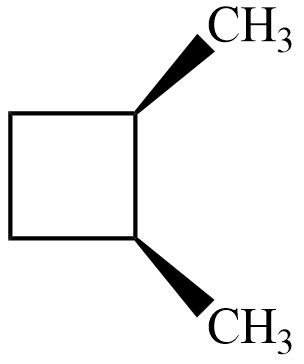
$ trans-1,2-dimethyl\;cyclobutane $
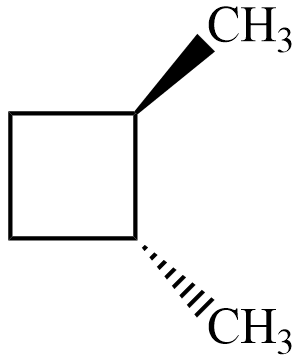
$ cis-1,3-dimethyl\;cyclobutane $
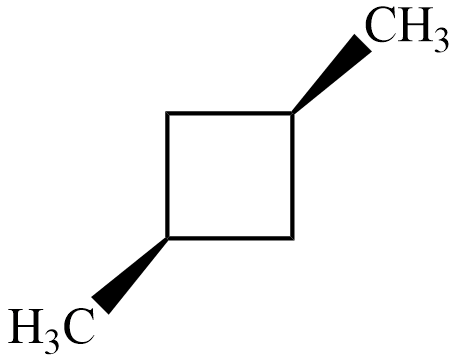
$ trans-1,3-dimethyl\;cyclobutane $
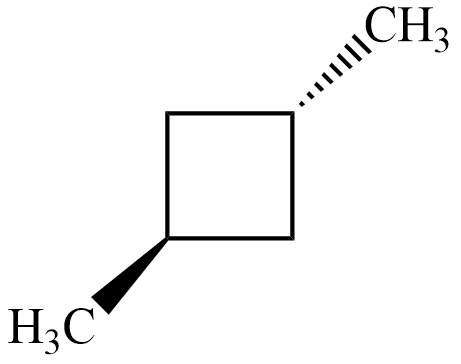
Now, for both the isomers of , there exists an axis of symmetry as shown below about which the compound is symmetrical
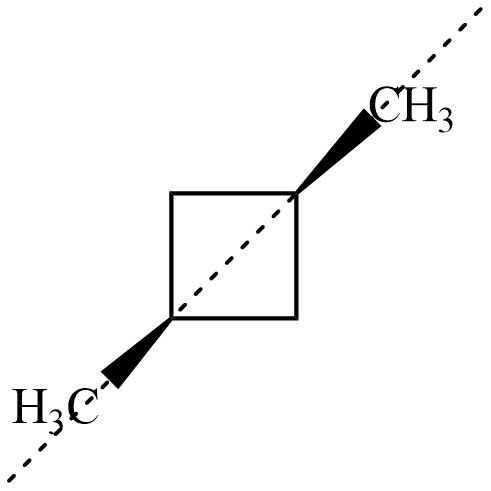
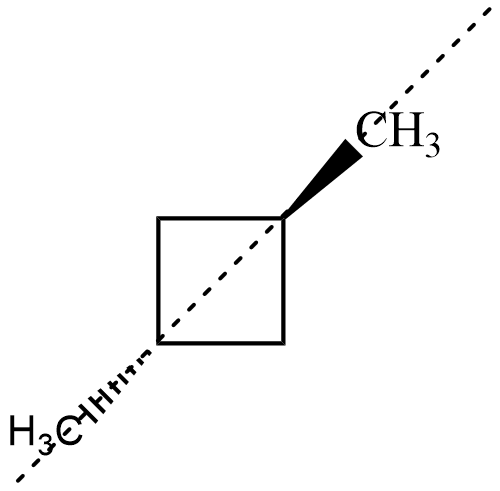
Hence, both isomers of $ 1,3-dimethyl\;cyclobutane $ are not optically active.
Now, for the isomer $ cis-1,2-dimethyl\;cyclobutane $ , there is no plane of symmetry but its mirror image is similar to original and hence superimposable as shown.
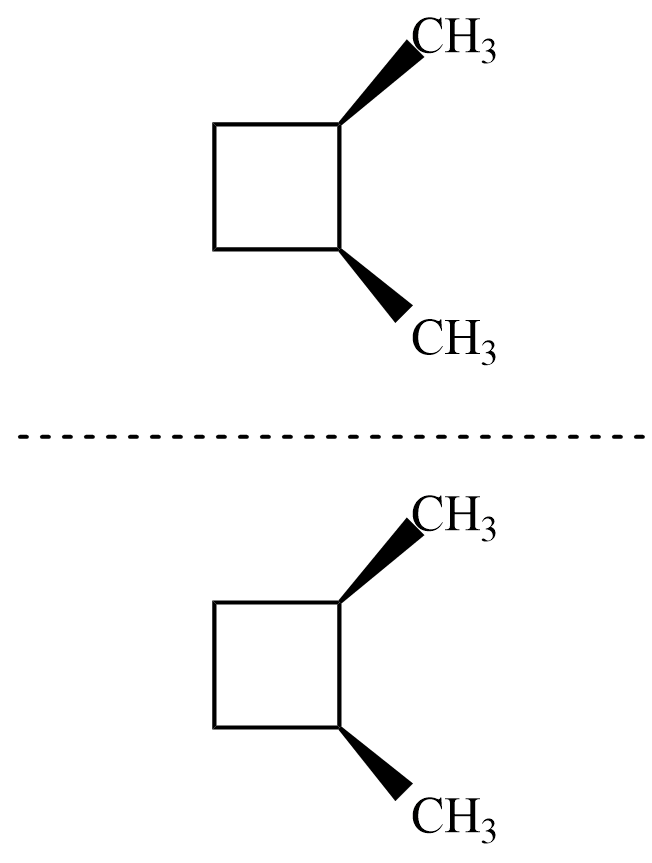
Hence, the isomer is achiral and thus not optically active.
For the isomer $ trans-1,2-dimethylbutane $ , its mirror image is as shown
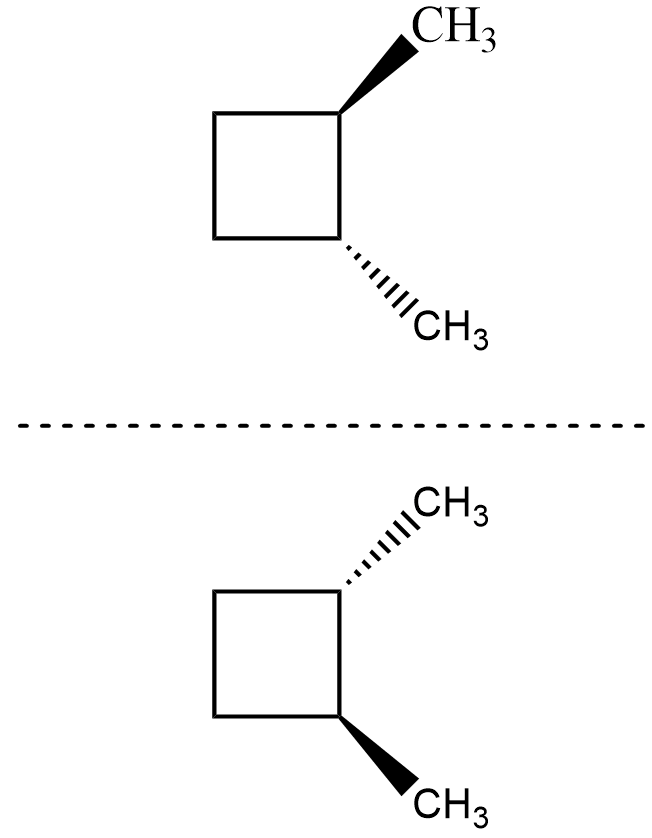
The mirror image is not superimposable on the compound and hence, it is chiral and thus optically active as we cannot find any plane or axis about which it is symmetrical.
Hence, the correct answer is Option $ (B) $ .
Note:
The point to understand here is that even though cyclobutane appears to be a planar compound, due to $ sp^3 $ hybridization, one of the carbons makes an angle of $ 25{}^\circ $ with the plane formed by the other three carbons. Also, we need to remember that for a compound to be optically active, it has to be asymmetric as well as chiral.
Complete answer:
An optically active compound is the compound that rotates the plane of polarized light, hence also known as polarizer.
To check whether the compound is optically active, we need to check if the compound is asymmetric as well as chiral.
For an asymmetric compound, it is not possible to find a point or an axis around which the compound is symmetric, meaning the sections on both sides of the point or axis are similar.
An asymmetric compound for hydrocarbons, can also be defined as the compound where all four valencies of carbon are satisfied by different groups.
A chiral compound is a compound whose mirror image taken from any of the axes is not superimposable on the original compound.
To find the optically active isomer of dimethylcyclobutane, let us draw the structures of all the given isomers.
$ cis-1,2-dimethyl\;cyclobutane $

$ trans-1,2-dimethyl\;cyclobutane $

$ cis-1,3-dimethyl\;cyclobutane $

$ trans-1,3-dimethyl\;cyclobutane $

Now, for both the isomers of , there exists an axis of symmetry as shown below about which the compound is symmetrical


Hence, both isomers of $ 1,3-dimethyl\;cyclobutane $ are not optically active.
Now, for the isomer $ cis-1,2-dimethyl\;cyclobutane $ , there is no plane of symmetry but its mirror image is similar to original and hence superimposable as shown.

Hence, the isomer is achiral and thus not optically active.
For the isomer $ trans-1,2-dimethylbutane $ , its mirror image is as shown

The mirror image is not superimposable on the compound and hence, it is chiral and thus optically active as we cannot find any plane or axis about which it is symmetrical.
Hence, the correct answer is Option $ (B) $ .
Note:
The point to understand here is that even though cyclobutane appears to be a planar compound, due to $ sp^3 $ hybridization, one of the carbons makes an angle of $ 25{}^\circ $ with the plane formed by the other three carbons. Also, we need to remember that for a compound to be optically active, it has to be asymmetric as well as chiral.
Recently Updated Pages
10 Examples of Evaporation in Daily Life with Explanations

10 Examples of Diffusion in Everyday Life

1 g of dry green algae absorb 47 times 10 3 moles of class 11 chemistry CBSE

What happens when dilute hydrochloric acid is added class 10 chemistry JEE_Main

What is the meaning of celestial class 10 social science CBSE

What causes groundwater depletion How can it be re class 10 chemistry CBSE

Trending doubts
Fill the blanks with the suitable prepositions 1 The class 9 english CBSE

Which are the Top 10 Largest Countries of the World?

How do you graph the function fx 4x class 9 maths CBSE

Distinguish between the following Ferrous and nonferrous class 9 social science CBSE

The term ISWM refers to A Integrated Solid Waste Machine class 10 social science CBSE

The Equation xxx + 2 is Satisfied when x is Equal to Class 10 Maths

Difference between Prokaryotic cell and Eukaryotic class 11 biology CBSE

Which is the longest day and shortest night in the class 11 sst CBSE

In a democracy the final decisionmaking power rests class 11 social science CBSE




